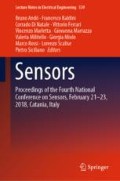Abstract
Dip-pen lithography (DPL) technique has been employed to develop a new flexible biosensor realized on nylon with the aim to detect the activity of human topoisomerase. The sensor is constituted by an ordered array of a DNA substrate on flexible nylon supports that can be exploited as a drug screening platform for anticancer molecules. Here, we demonstrate a rapid protocol that permits to immobilize minute quantities of DNA oligonucleotides by DPL on nylon surfaces. Theoretical and experimental aspects have been investigated to successfully print DNA oligonucleotides by DPL on such a porous and irregular substrate.
Access this chapter
Tax calculation will be finalised at checkout
Purchases are for personal use only
References
Segev-Bar, M., Haick, H.: Flexible sensors based on nanoparticles. ACS Nano 7, 8366–8378 (2013). https://doi.org/10.1021/nn402728g
Sun, Y., Wang, HH.: Electrodeposition of Pd nanoparticles on single-walled carbon nanotubes for flexible hydrogen sensors. Appl. Phys. Lett. 90, (2007).https://doi.org/10.1063/1.2742596
Farcau, C., Moreira, H., Viallet, B., Grisolia, J., Ciuculescu-pradines, D., Amiens, C., Ressier, L.: Monolayered wires of gold colloidal nanoparticles for high-sensitivity strain sensing. J. Phys. Chem. C 115, 14494–14499 (2011). https://doi.org/10.1021/jp202166s
Segev-Bar, M., Landman, A., Nir-Shapira, M., Shuster, G., Haick, H.: Tunable touch sensor and combined sensing platform: toward nanoparticle-based electronic skin. ACS Appl. Mater. Interfaces. 5, 5531–5541 (2013). https://doi.org/10.1021/am400757q
Martinez, A.W., Phillips, S.T., Whitesides, G.M., Carrilho, E.: Diagnostics for the developing world: micro fluidic paper-based analytical devices 82, 3–10 (2010). https://doi.org/10.1007/s10337-013-2413-y
Windmiller, J.R., Wang, J.: Wearable electrochemical sensors and biosensors: a review. Electroanalysis 25, 29–46 (2013). https://doi.org/10.1002/elan.201200349
Farahmand, E., Ibrahim, F., Hosseini, S., Rothan, H.A., Yusof, R., Koole, L.H., Djordjevic, I.: A novel approach for application of nylon membranes in the biosensing domain. Appl. Surf. Sci. 353, 1310–1319 (2015). https://doi.org/10.1016/j.apsusc.2015.07.004
Arrabito, G., Pignataro, B.: Solution processed micro- and nano-bioarrays for multiplexed biosensing. Anal. Chem. 84, 5450–5462 (2012). https://doi.org/10.1021/ac300621z
Khan, S., Lorenzelli, L., Dahiya, R.S.: Technologies for printing sensors and electronics over large flexible substrates: a review. IEEE Sens. J. 15, 3164–3185 (2015). https://doi.org/10.1109/JSEN.2014.2375203
Piner, R.D., Zhu, J., Xu, F., Hong, S., Mirkin, C.A.: “Dip-Pen” Nanolithography. Science 283, 661 LP-663 (1999)
He, Y., Ye, T., Su, M., Zhang, C., Ribbe, A.E., Jiang, W., Mao, C.: Hierarchical self-assembly of DNA into symmetric supramolecular polyhedra. Nature 452, 198–201 (2008). https://doi.org/10.1038/nature06597
Wang, J.C.: DNA topoisomerases. Nat. Rev. Mol. Cell Biol. 582, 209–219 (2009). https://doi.org/10.1007/978-1-60761-340-4
Leppard, J.B., Champoux, J.J.: Human DNA topoisomerase I: relaxation, roles, and damage control. Chromosoma 114, 75–85 (2005). https://doi.org/10.1007/s00412-005-0345-5
Zuccaro, L., Tesauro, C., Kurkina, T., Fiorani, P., Yu, H.K., Knudsen, B.R., Kern, K., Desideri, A., Balasubramanian, K.: Real-time label-free direct electronic monitoring of topoisomerase enzyme binding kinetics on graphene. ACS Nano 9, 11166–11176 (2015). https://doi.org/10.1021/acsnano.5b05709
Wang, L., Arrabito, G.: Hybrid, multiplexed, functional DNA nanotechnology for bioanalysis. Analyst 140, 5821–5848 (2015). https://doi.org/10.1039/C5AN00861A
Anderson, D.M.: Imbibition of a liquid droplet on a deformable porous substrate. Phys. Fluids 17, 87104 (2005). https://doi.org/10.1063/1.2000247
Arrabito, G., Reisewitz, S., Dehmelt, L., Bastiaens, P.I., Pignataro, B., Schroeder, H., Niemeyer, C.M.: Biochips for cell biology by combined dip-pen nanolithography and DNA-directed protein immobilization. Small 9, 4243–4249 (2013). https://doi.org/10.1002/smll.201300941
Na, G.C.: Interaction of calf skin collagen with glycerol: linked function analysis. Biochemistry 25, 967–973 (1986). https://doi.org/10.1021/bi00353a004
Andersen, A.H., Gocke, E., Bonven, B.J., Nielsen, O.F., Westergaard, O.: Topoisomerase I has a strong binding preference for a conserved hexadecameric sequence in the promotor region of the rRNA gene from Tetrahymena pyriformis. Nucleic Acids Res. 13, 1543–1557 (1985). https://doi.org/10.1093/nar/13.5.1543
Author information
Authors and Affiliations
Corresponding author
Editor information
Editors and Affiliations
Rights and permissions
Copyright information
© 2019 Springer Nature Switzerland AG
About this paper
Cite this paper
Ferrara, V. et al. (2019). DNA-Based Biosensor on Flexible Nylon Substrate by Dip-Pen Lithography for Topoisomerase Detection. In: Andò, B., et al. Sensors. CNS 2018. Lecture Notes in Electrical Engineering, vol 539. Springer, Cham. https://doi.org/10.1007/978-3-030-04324-7_39
Download citation
DOI: https://doi.org/10.1007/978-3-030-04324-7_39
Published:
Publisher Name: Springer, Cham
Print ISBN: 978-3-030-04323-0
Online ISBN: 978-3-030-04324-7
eBook Packages: EngineeringEngineering (R0)

